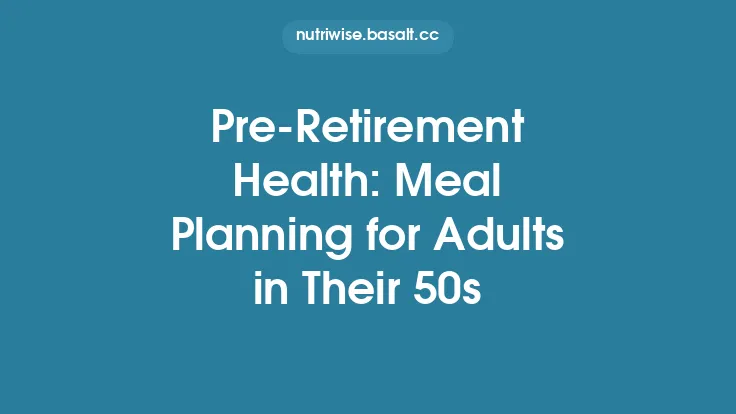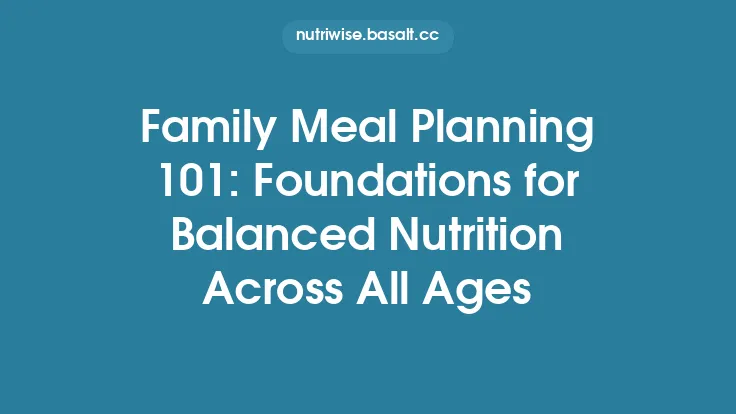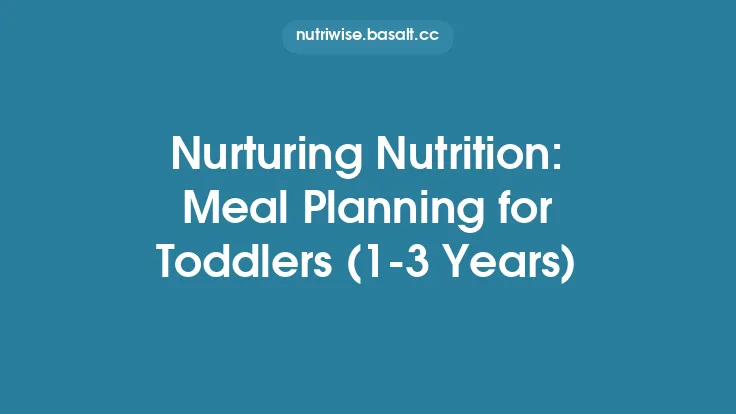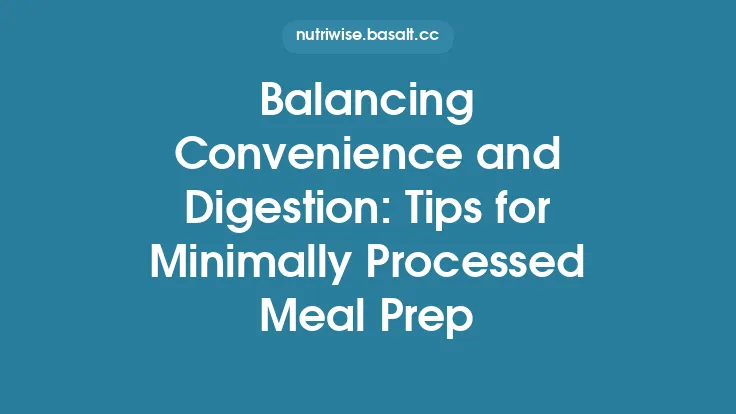Iron is a cornerstone of healthy blood formation, energy production, and immune function. For those who follow vegetarian or vegan diets, meeting daily iron needs can feel like a puzzle, especially because plant‑based sources provide non‑heme iron, which is generally less readily absorbed than the heme iron found in animal products. Yet, with thoughtful meal planning, it is entirely possible to build a diet that supplies sufficient iron while also delivering a wide array of other nutrients essential for overall well‑being. This guide walks you through the science of iron metabolism, the unique challenges faced by plant‑based eaters, and practical strategies to design iron‑rich meals that support anemia prevention over the long term.
Understanding Iron Metabolism in the Context of Plant‑Based Diets
Iron circulates in the body primarily bound to the protein transferrin, which delivers it to cells that need it for hemoglobin synthesis, mitochondrial respiration, and enzymatic reactions. The body tightly regulates iron balance: absorption in the duodenum is adjusted up or down according to iron stores, and excess iron is stored as ferritin in the liver, spleen, and bone marrow.
For vegetarians and vegans, the key metabolic considerations are:
- Non‑Heme Iron Bioavailability – Plant‑derived iron is absorbed via a different transporter (DMT1) and is more susceptible to inhibition by dietary compounds. Typical absorption rates range from 2–20 % compared with 15–35 % for heme iron.
- Regulatory Hormone (Hepcidin) – Hepcidin, produced by the liver, blocks iron export from intestinal cells and macrophages. Diets low in iron or high in erythropoietic demand (e.g., pregnancy, endurance training) suppress hepcidin, enhancing absorption. Conversely, chronic inflammation can raise hepcidin, reducing iron uptake even when dietary intake is adequate.
- Iron Turnover and Recycling – About 20 mg of iron is recycled daily from senescent red blood cells. Efficient recycling means that dietary iron needs are modest (≈8 mg/day for adult men, 18 mg/day for pre‑menopausal women), but the margin for error narrows when absorption is suboptimal.
Understanding these mechanisms helps you appreciate why meal composition, timing, and preparation matter as much as the raw iron content of foods.
Core Principles for Iron‑Rich Meal Planning
| Principle | Why It Matters | Practical Application |
|---|---|---|
| Aim for the Recommended Dietary Allowance (RDA) plus a safety buffer | Non‑heme iron’s lower absorption means you often need 1.5–2 × the RDA to achieve the same net iron gain as omnivores. | Target 12 mg/day for men and post‑menopausal women, 24 mg/day for pre‑menopausal women. Add ~30 % extra (e.g., 15 mg for men, 30 mg for women). |
| Distribute iron intake across meals | The intestine can only absorb a limited amount per sitting; spreading intake maximizes total absorption. | Include a modest iron source (≈3–5 mg) in each main meal and a small source (≈1–2 mg) in snacks. |
| Pair iron‑rich foods with absorption enhancers and avoid inhibitors in the same bite | Certain compounds (phytates, polyphenols, calcium) bind iron and block uptake; others (organic acids, certain amino acids) keep iron soluble. | Combine legumes with a squeeze of lemon juice or a splash of apple cider vinegar, but avoid drinking tea or coffee with the same meal. |
| Utilize food‑processing techniques that reduce inhibitors | Soaking, sprouting, fermenting, and cooking degrade phytates and polyphenols, improving iron’s bioavailability. | Soak beans 8–12 h, sprout lentils for 2–3 days, ferment tofu or tempeh, and use pressure cooking for whole grains. |
| Incorporate fortified foods strategically | Fortified cereals, plant milks, and nutritional yeast can provide a reliable iron boost without extra volume. | Choose a fortified breakfast cereal (≈4–6 mg iron per serving) and a calcium‑fortified soy milk (≈2 mg iron per cup). |
| Monitor and adjust based on life stage and activity level | Pregnancy, growth spurts, and high‑intensity training increase iron demand. | Increase daily iron targets by 30–50 % during these periods and consider more frequent iron‑rich meals. |
Building Iron‑Dense Meals: Food Group Strategies
Legumes and Pulses
- Why they shine: Chickpeas, lentils, black beans, and split peas are among the richest plant sources of iron (≈2–4 mg per ½ cup cooked).
- Preparation tips:
- Soak overnight, discard soaking water, then cook in fresh water.
- Add a splash of acidic liquid (e.g., lemon juice, tamarind) during cooking to keep iron soluble.
- Combine with whole grains (e.g., rice‑bean combos) to create a complete amino‑acid profile, which also modestly improves iron uptake.
Whole Grains and Pseudocereals
- Key players: Quinoa, amaranth, teff, buckwheat, and fortified oats.
- Iron contribution: 1 cup cooked quinoa ≈2.8 mg; fortified oatmeal ≈4 mg per serving.
- Enhancement methods:
- Ferment sourdough breads; the lactic acid produced reduces phytate levels.
- Toast seeds and nuts before adding to salads; heat diminishes some polyphenols.
Dark Leafy Greens and Brassicas
- Iron content: Spinach (≈3 mg per cooked cup), kale (≈1 mg), collard greens (≈2 mg).
- Caveat: Oxalates in raw greens bind iron; cooking reduces oxalate concentration by up to 50 %.
- Serving ideas:
- Sauté with garlic and a dash of vinegar.
- Blend into smoothies with a banana and a tablespoon of fortified nutritional yeast for a creamy, iron‑boosted drink.
Nuts, Seeds, and Dried Fruit
- Powerhouses: Pumpkin seeds (≈2.5 mg per ounce), hemp seeds (≈2 mg), dried apricots (≈1 mg per ¼ cup).
- Usage: Sprinkle seeds on oatmeal, blend nuts into sauces, or snack on dried fruit paired with a small portion of fortified cereal.
Fermented Plant Proteins
- Examples: Tempeh (≈2.7 mg per ½ cup), miso, fermented soy yogurt.
- Why they help: Fermentation breaks down phytates and produces peptides that can act as mild absorption enhancers.
- Meal integration: Marinate tempeh in a ginger‑soy glaze, then grill; add miso to soups for depth and iron.
Fortified Products
- What to look for: Check labels for “iron‑fortified” on plant milks, breakfast cereals, and nutrition bars.
- Caution: Some fortified foods also contain high calcium, which can inhibit iron if consumed together. Separate fortified iron sources from calcium‑rich foods (e.g., dairy alternatives) by at least 2 hours.
Sample Weekly Meal Plan (≈30 mg net iron/day)
| Day | Breakfast | Lunch | Dinner | Snack |
|---|---|---|---|---|
| Mon | Fortified oatmeal (4 mg) + pumpkin seeds (2 mg) + sliced banana | Quinoa‑black bean salad with lemon‑vinaigrette (5 mg) + kale chips (1 mg) | Stir‑fried tempeh with bok choy, brown rice (6 mg) | Dried apricots (1 mg) + a handful of almonds |
| Tue | Smoothie: fortified soy milk (2 mg) + spinach (2 mg) + nutritional yeast (1 mg) | Lentil soup (4 mg) + whole‑grain roll (1 mg) | Chickpea‑sweet potato curry with amaranth (7 mg) | Roasted pumpkin seeds (2 mg) |
| Wed | Buckwheat pancakes (3 mg) topped with tahini (1 mg) | Mixed bean wrap with avocado, salsa, and fermented cabbage (5 mg) | Baked tofu with roasted Brussels sprouts and millet (6 mg) | Apple slices with almond butter |
| Thu | Chia pudding made with fortified almond milk (3 mg) + berries | Farro‑spinach salad with orange segments and toasted hemp seeds (5 mg) | Red lentil dal with basmati rice (7 mg) | Trail mix (pumpkin seeds, dried figs) |
| Fri | Whole‑grain toast with hummus and sliced tomato (3 mg) | Tempeh “BLT” on sprouted rye bread (4 mg) + side of coleslaw | Vegan chili with kidney beans, quinoa, and corn (8 mg) | Dried apricots |
| Sat | Muesli with fortified oat milk (4 mg) + sliced kiwi | Sushi bowl: brown rice, edamame, avocado, pickled ginger (4 mg) | Eggplant‑lentil bake with a side of sautéed Swiss chard (6 mg) | Handful of roasted chickpeas |
| Sun | Savory oatmeal with miso, kale, and toasted sesame (4 mg) | Spinach‑tofu salad with orange‑ginger dressing (5 mg) | Stuffed bell peppers with quinoa, black beans, and tomato sauce (7 mg) | Nutritional yeast‑popcorn (2 mg) |
*Net iron values are approximate and assume typical portion sizes. Adjust portions upward for higher individual needs.*
Cooking Techniques That Maximize Iron Availability
- Soaking & Sprouting – Soaking beans, lentils, and grains for 8–12 hours activates endogenous phytases, which degrade phytates. Sprouting for 2–4 days further reduces inhibitors and adds vitamin C (a natural enhancer) without making the meal a focus on that nutrient.
- Fermentation – Incorporate sourdough starters, tempeh, miso, or fermented vegetables. The microbial activity lowers pH and produces organic acids that keep iron soluble.
- Pressure Cooking – High pressure and heat break down phytates more efficiently than conventional boiling, especially for whole grains and legumes.
- Acidic Cooking Liquids – Adding a tablespoon of vinegar or lemon juice to the cooking water of beans or grains can increase iron solubility by 10–15 %.
- Avoid Over‑Cooking Greens – While cooking reduces oxalates, excessive heat can leach minerals into the cooking water. Use minimal water and retain the cooking liquid (e.g., in soups) to preserve iron.
Timing and Pairing Strategies
- Separate Calcium‑Rich Foods – Calcium competes with iron for the same transport pathways. Schedule calcium‑dense meals (e.g., fortified soy milk, calcium‑rich tofu) at least two hours apart from iron‑focused meals.
- Limit Polyphenol Beverages During Meals – Tea, coffee, and certain herbal infusions contain tannins that bind iron. Enjoy them between meals rather than alongside iron‑rich dishes.
- Utilize “Iron‑Boosting Windows” – The body’s iron absorption peaks when hepcidin levels are low, typically 12–24 hours after an iron‑depleting event (e.g., intense exercise). Scheduling iron‑dense meals after such periods can modestly improve uptake.
Monitoring Iron Status Without Over‑Testing
While routine blood work is the gold standard for diagnosing iron deficiency, vegetarians and vegans can adopt a pragmatic self‑check routine:
- Track Energy Levels & Exercise Recovery – Persistent fatigue, reduced endurance, or frequent infections may signal low iron stores.
- Observe Nail and Skin Changes – Spoon‑shaped nails (koilonychia) or pallor can be early visual cues.
- Use a Food Diary – Log iron intake for a week; compare against target values (≈15 mg for men, 30 mg for women).
- Schedule Periodic Lab Panels – Every 6–12 months, request a complete blood count (CBC) with ferritin and transferrin saturation. This frequency balances vigilance with cost‑effectiveness.
If labs reveal low ferritin (<30 µg/L) despite adequate dietary intake, consider revisiting meal timing, inhibitor exposure, or the need for a short‑term iron supplement under professional guidance.
Adjusting the Plan for Special Situations
- Pregnancy & Lactation – Iron needs rise to ~27 mg/day. Emphasize fortified cereals, multiple legume servings, and frequent use of acidic cooking methods.
- Adolescence & Growth Spurts – Young vegans should aim for the higher end of the RDA; incorporate iron‑rich snacks like roasted chickpeas and fortified bars.
- Endurance Athletes – Increased red‑cell turnover demands more iron. Schedule iron‑dense meals post‑training and consider a brief iron‑rich “loading” phase (e.g., fortified smoothies) for 2–3 weeks.
- Elderly Vegans – Gastrointestinal absorption may decline with age. Focus on low‑phytate preparations, fortified foods, and possibly a low‑dose supplement after consulting a healthcare provider.
Budget‑Friendly Iron‑Rich Shopping List
| Category | Affordable Options | Approx. Iron per Serving |
|---|---|---|
| Legumes | Dried lentils, split peas, canned chickpeas (store brands) | 2–4 mg per ½ cup cooked |
| Grains | Bulk brown rice, rolled oats, whole‑wheat pasta | 0.5–2 mg per cup cooked |
| Seeds/Nuts | Sunflower seeds, pumpkin seeds, bulk peanuts | 1–2.5 mg per ounce |
| Greens | Frozen spinach, kale, collard greens | 1–3 mg per cup cooked |
| Fortified Products | Store‑brand soy milk, fortified cornflakes | 2–6 mg per serving |
| Dried Fruit | Bulk apricots, raisins | 0.5–1 mg per ¼ cup |
Buying in bulk, choosing store‑brand fortified items, and preparing legumes from dry rather than canned can dramatically reduce cost while preserving iron density.
Putting It All Together: A Step‑by‑Step Planning Workflow
- Calculate Personal Iron Target – RDA + 30 % safety buffer.
- Select Core Iron Sources – Choose 2–3 legumes, 1–2 whole grains, and a daily serving of fortified food.
- Map Preparation Methods – Assign soaking to beans, fermentation to tofu, and acidic cooking to grains.
- Create a Weekly Menu Grid – Use the sample plan as a template; swap in culturally familiar dishes while preserving iron‑rich components.
- Shop with a Checklist – Ensure each iron source appears at least once per day.
- Prep in Batches – Cook a large pot of lentils, a batch of quinoa, and a tray of roasted seeds on Sunday; store in portioned containers.
- Assemble Meals Quickly – Combine pre‑cooked components with fresh vegetables and sauces during the week.
- Monitor & Adjust – After 4–6 weeks, review energy levels and, if possible, lab results; tweak portion sizes or add another fortified item if needed.
Final Thoughts
Iron‑rich meal planning for vegetarians and vegans is less about hunting for a single “magic” food and more about orchestrating a symphony of ingredients, preparation techniques, and timing cues that together overcome the inherent absorption challenges of non‑heme iron. By grounding your diet in the principles outlined above—adequate intake, strategic distribution, inhibitor management, and regular monitoring—you can sustain healthy iron stores, ward off anemia, and enjoy the diverse, flavorful meals that plant‑based eating offers. Remember, consistency is key: a well‑designed weekly plan, executed with simple culinary tricks, provides a reliable foundation for lifelong iron health.





